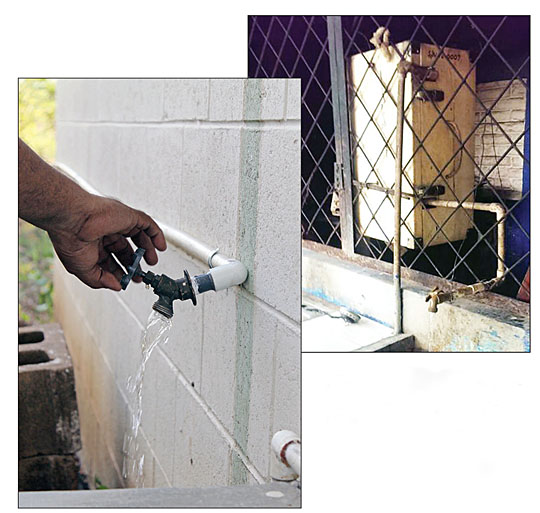Four students from UT’s College of Engineering traveled with Dr. Glenn Lipscomb to El Salvador this summer to install a water treatment unit they built earlier in the year.
Kylee Kramer, Alison Haas and Lisa Young, chemical engineering majors, and Kayla Piezer, environmental engineering major, turned their freshman design project into a real-world solution.

The UT team, from left, Kayla Piezer, Lisa Young, Alison Haas, Kylee Kramer and Dr. Glenn Lipscomb, posed for a photo with the water purification unit that the students constructed in Toledo before taking it to El Salvadore.
Following the completion of their freshman design experience and orientation class, Kramer, Haas, Young and Piezer sought funding for a trip to install their treatment unit in El Salvador, where contamination makes access to clean drinking water an increasingly urgent issue. The students collaborated with the Centro de Intercambio y Solidaridad (Center for Exchange and Solidarity) to plan their trip, seeking donations from external donors and obtaining partial support from The University of Toledo.
“This trip provided the real-world experience that is needed to understand the impact of engineering design on the adoption and use of technology to improve the human condition,” Lipscomb, professor and chair of chemical and environmental engineering, said.

The purification unit was installed at the San Pablo Tacachico health clinic and provides clean water.
As part of the trip, the student team learned about efforts by the Center for Exchange and Solidarity to support local economic development, create businesses led by women, provide high school and university scholarships, and spread awareness of proper hygiene practices. The team also spent time with local families in Comasagua.
“It was incredible to expand our freshman design project to make a global impact while connecting with the community in El Salvador,” Piezer said. “It gave us the opportunity to examine the specific needs of a different environment, which led to an understanding of the community’s way of life and allowed us to build relationships on a personal level.”
“The journey from design project to real-world application was worth every minute. And seeing the effect our unit had on the communities in El Salvador had a great impact on me,” Haas said. “Though the design project itself had significance, interacting with the people of El Salvador and experiencing their way of living gave me a new outlook on the value of our unit and clean water in general. I am extremely grateful for this opportunity.”
Incoming students in the freshman orientation course will continue to build water treatment units as part of the freshman design experience, according to Lipscomb. They will explore improvements to installation, maintenance and performance. The department intends to facilitate future trips to deliver the water treatment units to communities in need.
“I’ve never really been a person who likes to travel, but this trip was one of the most gratifying experiences of my life,” Young said. “It helped broaden my views of different cultures and expand my abilities as an engineer.”
“This trip allowed me to use the skills that I learned in the classroom and put them to use in the real world,” Kramer said. “It was also an amazing experience to see the culture and people of El Salvador while helping them receive a vital aspect of life.”